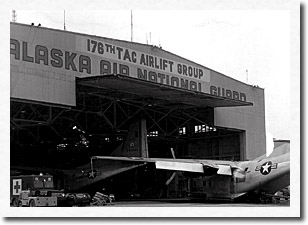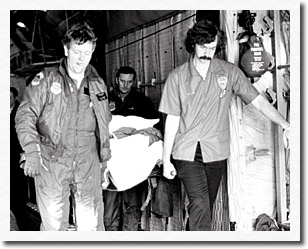 |
| History > 1970s |
 |
 
1970s
"KULIS AIR NATIONAL GUARD BASE IS MANNED AND COMMANDED BY HOMETOWN MEN," noted the 1969 revision of the Alaska Air National Guard Handbook. "A typical Air Guardsman is a young family man, carving a future for himself. He is vitally interested in Alaska and its future."
Just a year later, that description -- part of it, anyway -- would have to be changed as the chief nurse at Fort Richardson, Capt. Marjorie Paulson, became the first woman to join the Alaska Air National Guard.
Paulson said that while the Guard took a year to decide whether to accept her application -- "There certainly were people who didn't think women belonged in the Guard," she told the Air Guardian after retiring in 1997 -- her admission to the 176th Tactical Dispensary actually generated little fuss around Kulis.
The media was another matter. "HURDLING THE MALE BARRIER" blared a large headline in the Anchorage Daily News. "AIR GUARD GOES CO-ED" said another.
"So that was my claim to fame," Paulson would joke years later.
It didn't take long for others to follow in her footsteps. The next year, Jennifer Huebner became the first female Alaska Air National Guard enlistee (Huebner was also the first woman in the country to join a National Guard civil engineering unit).
 Steady growth Steady growth
The Alaska Air National Guard's reorganization as a group in 1969 had set the stage for future expansion. By the end of 1970 four squadrons had been organized to perform the flight operations, maintenance, supply and support functions. Along with the tactical dispensary had been added a communications flight and a civil engineering unit to give the Group the "total react capability" enjoyed by Guard units in the other 49 states. The 176th's focus on tactical airlift missions would not change, however. In fact, it was to be expanded, and the Group was authorized another 475 positions on top of its 275 existing slots.
Another obvious sign of progress was the increasing extent to which the Alaska Air National Guard was integrating its operations with the U.S. Air Force and other Air National Guard units. In the Fall of 1971, Kulis hosted three "Prime BEEF" (Base Emergency Engineering Force) Air Guard teams from Colorado, Iowa and Nevada. Serving their two weeks of annual active duty, the visiting Guard members built a modular dormitory, a small arms target range, several parking areas and a base entry gate on Kulis. It was the first time such units were deployed to help another Guard unit outside their home states.
The next year, it would be the Alaskans' turn to mobilize. The 176th Civil Engineer Flight sent their own Prime BEEF team first to Arizona to work on several construction projects, then to Nellis Air Force Base, Nev., to attend a five-day Prime BEEF exercise. The next year found a 60-member Alaska Prime BEEF team in Osan Air Force Base, Korea, helping to build a chapel, rebuild an ambulance facility and augment the base's fire crew.
Even as America began to suffer through the post-Vietnam era, the Alaska Air National Guard continued to enjoy political and public support. In 1974 Kulis added a new Operations Center and a multipurpose building, and recruiting levels would increase steadily before dropping off somewhat toward the end of the decade.
 Bigger planes for bigger things Bigger planes for bigger things
The 144th Tactical Airlift Squadron's mission was changed to worldwide airlift in 1976, and it was assigned to the Military Airlift Command as the "gaining" command in the event it was federalized for active duty. A mechanical upgrade was in order, and after 16 years of service the unit's C-123s were replaced with C-130E "Hercules" transports, boasting increased speed, range and carrying capacity.
(The C-123s were returned to the Air Force, which was then to give them to the South Korean Air Force. Getting them to Korea, however, posed an unforeseen problem: the planes were so old no one in the USAF had any experience flying them. The problem was solved when one pilot and one mechanic from the Group flew to Arizona -- together with a load of out-of-print repair manuals and no-longer-manufactured parts -- to teach their USAF counterparts how to fly and maintain the old birds.)
 Building the total force Building the total force
By this time, the increasing integration between active duty and reserve-component military forces had progressed the point where the concept had a name of its own: the Total Force.
"In short,Total Force stresses a 'shared responsibility' among all service components of this nation," Group Commander Lt. Col. Edward Belyea wrote in the Airlift newsletter. "No longer do these Reserve forces have to depend on obsolete equipment handed down to them by their "big brother" active duty force."
With its new C-130s, the 176th Group began participating in the Total Force almost immediately, flying to Panama, Germany, Korea and elsewhere to support U.S. military and humanitarian missions. It also began taking on greater responsibilities in the annual Brim Frost joint force exercises, and took part in the "Red Flag" wargames program in Nevada.
All this new activity would require a stronger support infrastructure, and in 1977 Alaska Air National Guard kicked off one of its largest construction projects ever. More than $3 million was invested in a new composite maintenance building, an aerospace ground equipment (AGE) support building and a new petroleum operations facility on Kulis.
|
|
|
 |
| |
1971
Lt. Col. Dempsey Anderson becomes the first AKANG member to receive the Meritorious Service Medal. The citation notes he personally recruited 60 new members to the group.
1973
Maj. Gen. William "Pappy" Elmore retires as ANG adjutant general. He joined the AKANG as a flying instructor in 1954, and served two separate stints (1964 to 1966 and 1971 to 1973) in the Alaska National Guard's top spot.
1975
Another first. Airlift magazine reports that Amn. Chris Ditty, a married mother of six, has returned from basic training and tech school to become the AKANG's first female aircraft mechanic.
1976
Total Force concept begins to be implemented. 144th's mission changes to worldwide airlift.
1977
Firefighters from Kulis respond to crash of a Japan Airlines DC-8 at the Anchorage International Airport.
1978
AKANG flies surplus World War II torpedo netting to Bethel to help shore up the town's eroding waterfront.
1979
40,000 hours accident-free: A new Group safety mark. |
|
| |
|
|



